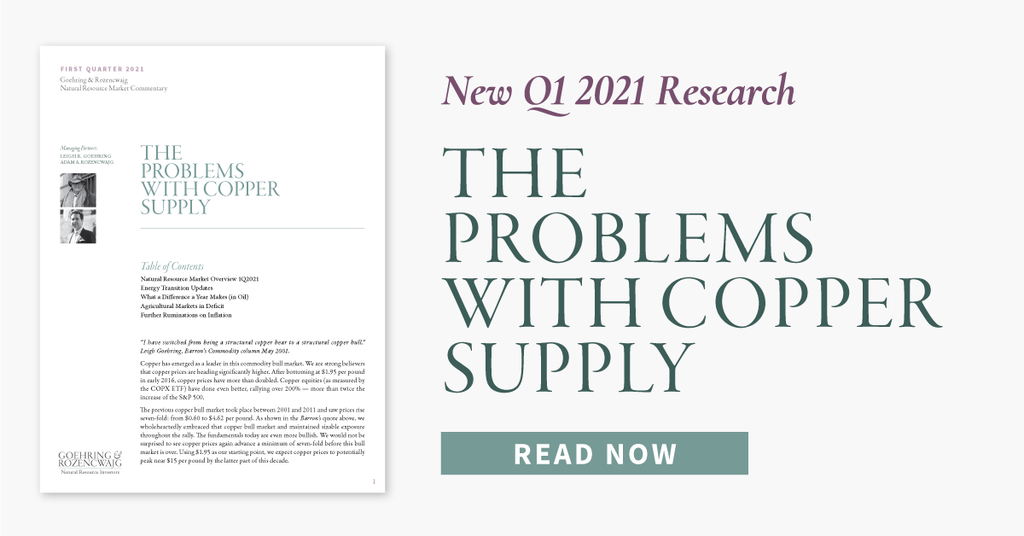Non-OPEC+ production outside of the US is facing challenges similar to the situation with the US shales. In their most recent report, the IEA reports that non-OPEC+ production outside of the US was down 500,000 b/d in March compared with a year earlier. The IEA projects production from this group will grow throughout the year and that by 4Q21, supply will be 700,000 b/d higher than a year earlier. We disagree with this assessment and expect production will fall short by as much as 400,000 b/d, if not more. Exploration outside of the shales has been extremely disappointing over the past decade and new project sanctions have barely been able to replace base declines. Given the capital budget curtailments around the world, we expect non-OPEC+ production outside of the US will continue to disappoint going forward.
Meanwhile, demand is normalizing following the COVID-19 disruptions last year. Although global demand remained 5 mm b/d below its pre-COVID level in 1Q21, it continues to trend in the right direction.
Some countries have now either regained or surpassed pre-COVID demand levels. In 1Q21, Chinese demand was likely 1.4 m b/d higher than the same period in 2019. Indian demand was likely within 10,000 b/d of its pre-COVID record as well. Therefore, the two largest sources of demand growth in recent years are now back to their pre-COVID levels. The surge in Indian case data suggests demand may be impacted in 2Q21, but nevertheless the latent demand in the underlying economy appears very strong. This is exactly what we predicted would occur as a direct result of the S-curve. As we have explained in the past, when a country reaches a certain level of per-capita real GDP, their commodity intensity begins to move up dramatically. China and India are both firmly in their S-curve sweet spots and so it is no surprise they are the two countries that are most quickly regaining their pre-COVID demand peaks.
As the COVID-19 vaccination distribution continues to accelerate globally, we believe demand will rebound very sharply from here. Indications point to substantial pent-up demand for both leisure and business travel once restrictions are lifted. Government policies meanwhile have left savings rates at all-time highs.
Looking forward through the rest of this year, we believe oil market deficits will accelerate, causing inventories to plummet. The IEA currently estimates demand will average 97.6 mm b/d for the remainder of the year. To the extent global vaccine distribution accelerates, we believe this figure could be too low by as much as 1.5 mm b/d. Non-OPEC+ production is expected to grow by 1.8 mm b/d, driven by nearly 1 mm b/d of growth from the US shales. We simply do not believe this is likely given our modeling of core exhaustion and productivity trends. Instead of growing by nearly 1 mm b/d from here, we believe total US production will continue to fall by as much as 400,000 b/d. Based on their figures, the IEA expects the call on OPEC+ to average 44.6 mm b/d for the rest of the year compared with actual production of 41.3 m b/d in April. Assuming OPEC+ returns production according to their recently announced schedule, the IEA expects the market to remain in deficit by 1 m b/d for the remainder the year. Making the adjustments we described (increasing demand and decreasing US shale output), we believe the deficit will exceed 3.5 m b/d, causing inventories to approach record low levels. If our models continue to be correct, global oil markets should remain in deficit even if OPEC+ returns to producing at its all-time high levels.
As our readers know, we favor those companies with high-quality assets and sensible balance sheets that trade at favorable valuations. These companies should continue to generate material value as the cycle progresses. One metric we like to use is proved reserves per net debt adjusted share. If a company has high quality assets, it should be able to grow its proved reserves per share; adjusting for net debt helps account for capital discipline. Looking at the universe of US E&P companies, we estimate the market cap-weighted group saw proved reserves per net debt adjusted share fall by 6% for the second consecutive year. Proved developed reserves (leaving aside future undrilled locations) fell by 4%. Our position-weighted average group of companies on the other hand were able to grow proved reserves by 3% and proved developed reserves by 8%. We believe this is a quick way of confirming that we continue to identify the best remaining assets in the US shale basins.
We are entering into a new era in global oil markets. While most analysts are concerned about demand, the most important driver will likely be supply. After a decade of robust growth, the US shales are now exhausted, and incremental growth will be very difficult to achieve. Two decades ago, investors worried we were running out of oil while today’s investor worries that we have passed peak demand. Although we cannot say for certain what the coming decade will bring, it will almost certainly defy conventional expectation. The US shales have been an extremely prolific source of supply but we firmly believe their best days are behind them. As this realization sinks in, we believe investors will focus on those companies with the remaining high-quality assets. We recommend investors maintain sizable investments in high quality E&P and oil service companies with a considerable earnings leverage to higher oil prices.
To read more on this subject, we encourage you to download the full commentary, available below.



